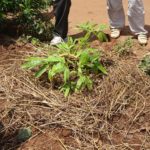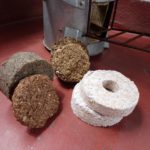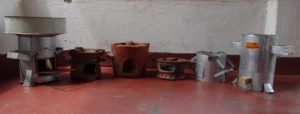Biomass is all organic material derived from living or recently living organisms (animals and plants). If we make the energy stored in wood, wood waste, straw, crop residues, manure, sugar cane etc. available we use Biofuel to generate Bioenergy. Some of the plants are called biofuel directly after harvest, others are former waste materials from agricultural, domestic or industrial processes. Making available means burning the biomass as it is or converting it into other useable forms of energy in solid, liquid or gas form first, e.g. biogas (anaerobic digestion), biodiesel (made from oils) and ethanol (fermentation of crops). It can be used for cooking/heating, transportation and generation of electricity.
In theory biofuels are considered carbon-neutral as the carbon dioxide that is released in combustion is equal to the amount that is absorbed by the next plant generation. That is the theory. However, the practice in Malawi looks quite different.
Bioenergy for cooking/heating
The Status-Quo in Malawi
Cooking is the most energy-intense practice in common Malawian households. And this need is nearly entirely met with biomass, namely charcoal and fuelwood. This fuelwood is the main source of energy in Malawi, unlike grid electricity which has in fact only quite a small share.
In rural areas the most widespread source of cooking fuel is firewood, in urban areas people tend to prefer charcoal. The main cooking device is Three Stone Fire which is very inefficient (meaning it consumes vast amounts of wood for providing only a small portion of heat to our pot), followed by simple charcoal stoves. Apart from households many businesses and industries such as tea plantations and brick-making places also rely on solid biomass.
Both firewood and charcoal are part of an unsustainable cycle of cutting down trees without replanting them. Solid biofuels have become the main driver of deforestation in this country with its many adverse effects on the quality of the land (e.g. desertification, soil erosion, siltation of rivers) and beyond (e.g. climate change with extreme weather conditions, long distances for collecting firewood, low electricity generation capacity at the rivers). Charcoal is even worse when it comes to its impact on the forest cover: one tree is cut down for one bag of charcoal or around ten bags of firewood.
Besides this, using charcoal and firewood as fuel puts the health of people at danger (through Indoor Air Pollution, the risk of burns and the danger of rape when collecting firewood). See “Energy Poverty”.
Biomass is the main source of energy in Malawi. So this is where to start making Malawi’s energy consumption renewable.
Ways to go
We can take two basic measures to reduce the negative impact of the current unsustainable and harmful use of biomass:
1.
We make our use of fuelwood more efficient through the implementation of Improved (Biomass) Cookstoves and change of consumer behaviour.
2.
We use alternatives to charcoal and firewood for which no trees are cut down carelessly and that do not harm our health. Basically any organic material can be used, not only living trees. We can either burn it directly as an alternative to firewood or turn it into charcoal, briquettes or even gas.
Here are some ideas to get creative:
The reason why bamboo is so suitable to cover our biomass needs is that it regrows at a very fast rate. This means we can harvest regularly without destroying the plant (unlike trees that die when we cut them down).

Bamboo generally grows well in Malawi and is not very picky when it comes to soil and weather conditions. However, the better we care for our plant the faster we can start harvesting. It usually takes about 3 to 4 years until it is big enough to regrow quickly.
The pieces that we cut off can either be dried and burnt as a substitute to firewood or processed to charcoal.
Instead of firewood we can use biomass residues and woody plants to burn them directly. Some examples are pigeon pea (nandolo) sticks, twigs from trees or maize stalks. Cookstoves like the Chitetezo Mbaula burn very good on small pieces of wood.
Tip: As a farmer you can plant a hedge of pigeon peas around your field. Apart from supply of fuelwood you will get additional benefits: it prevents soil erosion, works as a wind breaker and provides nitrogen to your plants (like a natural fertilizer).
Charcoal is only bad if we produce it from wood that is taken without giving back. There is one initiative in Malawi so far that produces sustainable wood charcoal (meaning the trees are replanted after cutting them).
And as already mentioned we can burn charcoal from different biomass like bamboo too.

Recycle Biomass Briquettes are made through mechanical compression of organic waste. We can use an abundance of waste materials such as waste paper, tobacco leaves, sawdust, elephant dung, banana leaves, coffee and peanut husks, charcoal dust, all kinds of dry plant fibres and so on. Just take what is available in your region and go for creative combinations. Depending on the used material, on the grade of compression and some other factors the briquettes can have heating value and duration that is similar to or even better than charcoal. All this without emitting the same smoke and soot and without tree cutting.
Biogas is produced through the digestion of organic matter by anaerobic bacteria in an oxygen-free surrounding. In other words: Biomass like agricultural materials (crop residues, manure, energy crops), vegetable scraps, animal waste, even municipal and sewage waste is left in a container without air coming in. Bacteria that do not like air are going to come and eat the biomass. While doing this they produce methane gas. We can collect this gas and use it for cooking, lightning and even electricity generation. When used for cooking there is hardly any smoke (even less than in common Improved Cookstoves) and as a pleasant side effect biogas production helps with sanitation and waste recycling. A challenge hindering the uptake of biogas is that it requires a certain degree of technical knowledge and start capital.

